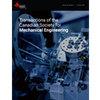2-P(RPS+UPS)六自由度并联机构运动特性分析
IF 1
4区 工程技术
Q4 ENGINEERING, MECHANICAL
Transactions of The Canadian Society for Mechanical Engineering
Pub Date : 2023-07-21
DOI:10.1139/tcsme-2022-0156
引用次数: 0
摘要
目前,对零件装配所需工作空间的需求越来越大,迫切需要一种具有大工作空间的并联机构来弥补这一缺口。为此,本文提出了一种具有四支链、六自由度的2-P(RPS+UPS)并联机构(其中S、P、R、U分别代表球面、移动关节、转动关节和万向关节),并对其运动学特性进行了分析。首先,利用ADAMS软件对2-P(RPS+UPS)并联机构的速度进行了数值推导和仿真验证。然后,从机构输入输出速度和位置关系的表达式出发,分析了机构的运动解耦特性。为了使工作空间中各分支受力最小,对2-P(RPS+UPS)机构和Stewart机构进行了尺度优化。进一步对2-P(RPS+UPS)机构的灵巧性、奇异性和工作空间进行了分析,并与Stewart机构进行了性能比较。该并联机构具有分支少、运动模型简单、运动解耦强、承载能力强、工作空间大、初始位置高度低等特点。此外,它可以方便地运输和储存。因此,在需要较大工作空间的装配和姿态调整场景中具有良好的应用前景。本文章由计算机程序翻译,如有差异,请以英文原文为准。
Analysis of Kinematic Characteristics of 2-P(RPS+UPS) Parallel Mechanism with Six Degrees of Freedom
At present, there is an increasing demand for the workspace required for assembly of components, and a parallel mechanism with large workspace is urgently needed to make up for it. Therefore, in this paper, a 2-P(RPS+UPS) parallel mechanism (where S, P, R, and U represent spherical, prismatic, revolute, and universal joints) with four branched chains and six degrees of freedom is proposed and its kinematic characteristics are analyzed. First, the speed of the 2-P(RPS+UPS) parallel mechanism is numerically derived and verified by simulation using ADAMS software. Then, the motion decoupling characteristics of the mechanism are analyzed from the expression of the speed and position relationship between the input and output of the mechanism. To minimize the force on each branch in the workspace, scale optimization of the 2-P(RPS+UPS) mechanism and the Stewart mechanism is performed. Further, analysis of the dexterity, singularity, and workspace of the 2-P(RPS+UPS) mechanism are conducted, and the performance of the mechanism is compared with that of the Stewart mechanism. The proposed parallel mechanism has fewer branches, a simple kinematic model, strong motion decoupling, high bearing capacity, a large workspace, and a low initial position height. Moreover, it can be conveniently transported and stored. Therefore, it has good application prospects in assembly and posture adjustment scenes requiring large workspace.
求助全文
通过发布文献求助,成功后即可免费获取论文全文。
去求助
来源期刊
CiteScore
2.30
自引率
0.00%
发文量
53
审稿时长
5 months
期刊介绍:
Published since 1972, Transactions of the Canadian Society for Mechanical Engineering is a quarterly journal that publishes comprehensive research articles and notes in the broad field of mechanical engineering. New advances in energy systems, biomechanics, engineering analysis and design, environmental engineering, materials technology, advanced manufacturing, mechatronics, MEMS, nanotechnology, thermo-fluids engineering, and transportation systems are featured.

 求助内容:
求助内容: 应助结果提醒方式:
应助结果提醒方式:


